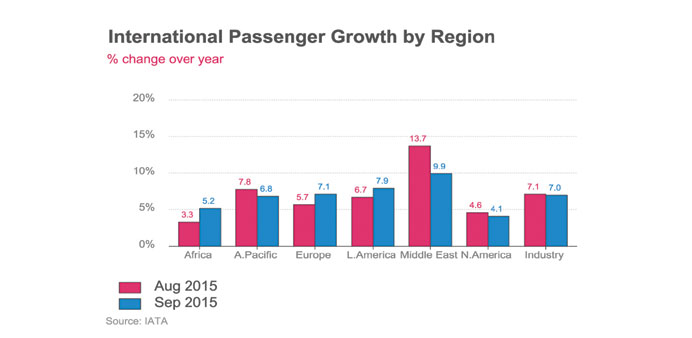International air travel on Middle Eastern carriers rose 9.9% in September year-on-year, shows IATA’s latest passenger market analysis.
This, according to IATA, was a slowdown on August, but it said “the near double-digit growth is still very strong and it is premature to conclude that growth is slowing.”
Major economies in the Middle East, including Saudi Arabia and the UAE, have seen slowdowns in non-oil sectors in the second quarter, but the rates of growth remain robust and this should help sustain solid expansion in air passenger demand for local carriers, it said.
Global air travel rose 7.3% in September compared to a year ago, the IATA report said.
The mid-year data showed “some distortion” from holiday impacts, but the last couple of months confirmed that the strong demand trend was continuing, despite some softening in global economic growth, mostly in emerging markets.
Growth in air travel, particularly the more price sensitive economy class leisure travel, has received some support from lower fares. After a brief moderation in volumes in mid-2015, the industry expanded throughout the third quarter, resuming the robust growth trend seen earlier in the year.
Air travel growth for carriers in major regions remains robust. Asia Pacific, Europe and North America recorded gains of 6.8%, 7.1% and 4.1%, respectively year-on-year.
Despite weakness in trade activity in Emerging Asia, as well as slower than expected growth in China, there has been no adverse impact to date on international RPKs (revenue passenger kilometers ) for Asia Pacific carriers.
Economic recovery in the eurozone and stronger demand conditions in H2 in the US are supporting international air travel on carriers in these regions.
Domestic markets showed considerable variation in performance in September. India continues to record very strong growth, up 13.2%, largely reflecting notable increases in service frequencies as well as ongoing economic strength.
By contrast, air travel in Japan rose just 2% in September year-on-year, hampered by fragile economic conditions.
“Industry load factors dipped slightly in September, after reaching an all-time high in August. The decline in seasonally adjusted load factors resulted from a stronger pick-up in capacity that outstripped growth in demand. However, levels are still very high and indicative of the strong demand growth in most regions.
“Despite the recent moderation in economic activity in a number of emerging markets, particularly China, improved conditions in developed economies, combined with the fall in oil prices since mid-2014, is expected to support growth in demand for passenger travel throughout the remainder of 2015 and into the New Year,” IATA said.

